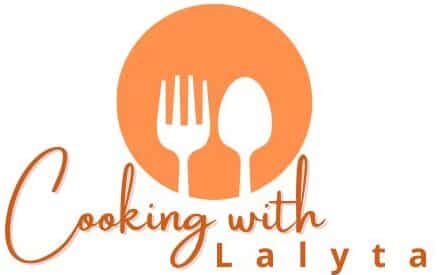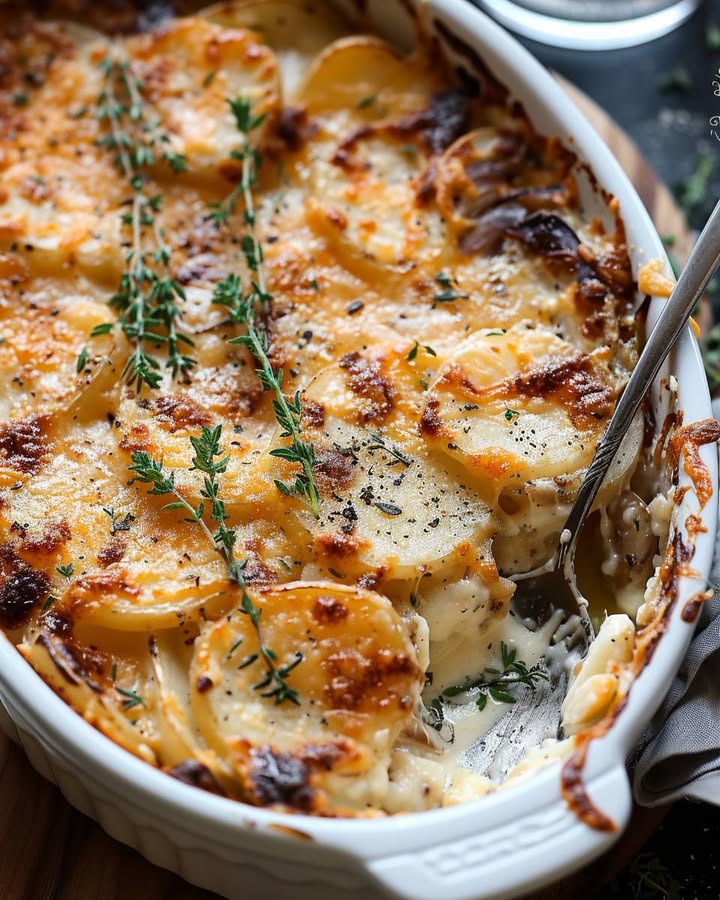Classic Scalloped Potatoes with Gruyere and Cheddar: A Creamy Comfort Food Masterpiece
Classic Scalloped Potatoes with Gruyere and Cheddar delivers the ultimate comfort food experience. This dish combines thinly sliced potatoes with a rich, creamy sauce and two types of cheese for maximum flavor. The Gruyere adds nutty depth while the cheddar provides sharpness, creating a perfect balance. When baked, the top forms a golden crust that gives way to tender, flavorful layers underneath.
Perfect for family dinners or holiday gatherings, these scalloped potatoes work as both a side dish and a main course. The recipe uses simple ingredients that transform into something extraordinary through careful layering and slow baking. Moreover, the aroma of melting cheese and roasting potatoes will fill your kitchen with irresistible smells. Whether serving a crowd or meal prepping for the week, this dish satisfies every time.
Quick Recipe Highlights
- Flavor Profile: The combination of Gruyere and cheddar creates a complex, savory taste with nutty and sharp notes. Garlic and thyme add aromatic depth to the creamy sauce.
- Texture: Thinly sliced potatoes become perfectly tender while the cheese sauce thickens during baking. The top layer develops a satisfying crispness.
- Aroma: As the dish bakes, the smell of melting cheese, roasted potatoes, and herbs will make your kitchen smell incredible.
- Visual Appeal: Golden brown crust contrasts beautifully with the creamy white and yellow layers underneath. Garnish with fresh herbs for extra color.
- Skill Level Needed: Basic knife skills and sauce-making ability help, but the recipe remains approachable for most home cooks.
- Special Equipment: A mandoline slicer ensures even potato slices, but a sharp knife works too. You’ll also need a 9×13 baking dish.
Recipe Overview
- Difficulty Level: This recipe requires some attention to detail when making the sauce and layering, but the steps remain straightforward. Perfect for cooks looking to expand their skills.
- Category: Hearty side dish that can anchor a meal when paired with protein and vegetables. Also works for brunch or potlucks.
- Cuisine: Rooted in French and American comfort food traditions, with Swiss influence from the Gruyere cheese.
- Cost: Uses affordable pantry staples with cheese as the splurge ingredient. Feeds a crowd economically.
- Season: Ideal for cooler months but works year-round. Particularly popular during holiday seasons.
- Occasion: Equally at home on weeknight dinner tables and special occasion buffets. Always a crowd-pleaser.
Why You’ll Love This Recipe
The combination of textures in Classic Scalloped Potatoes with Gruyere and Cheddar creates a truly satisfying eating experience. Crisp edges give way to creamy centers, while the cheese sauce binds everything together perfectly. Each bite delivers comfort and flavor in equal measure. Furthermore, the dish reheats beautifully, making it ideal for meal prep or leftovers.
From a preparation standpoint, this recipe offers flexibility. You can assemble it ahead of time and bake when needed. The ingredient list stays simple, focusing on quality rather than quantity. Additionally, the technique of layering ensures even cooking and distribution of flavors throughout the dish.
Nutritionally, potatoes provide potassium and fiber while the dairy contributes protein and calcium. When enjoyed in moderation as part of balanced meals, this dish fits into various eating plans. The protein from the cheese also helps balance the carbohydrates from the potatoes.
For entertaining, Classic Scalloped Potatoes with Gruyere and Cheddar always impresses guests. The presentation looks elegant yet homey, and the familiar flavors please diverse palates. It pairs well with numerous main courses from roasted meats to vegetarian options.
Cost-conscious cooks appreciate how this recipe stretches premium ingredients. A small amount of Gruyere goes far when combined with more affordable cheddar. The potatoes act as an economical base that soaks up all the delicious flavors.
Historical Background and Cultural Significance
Scalloped potatoes trace their origins to 18th century England, where cooks baked sliced potatoes in cream sauces. The term “scalloped” originally referred to the method of baking in a scallop shell, then evolved to describe any baked dish with layered ingredients. French cuisine later refined the technique, adding cheese to create what we now know as potatoes au gratin.
When European settlers brought these techniques to America, the dish adapted to local ingredients. Cheddar cheese became a popular addition due to its availability. The combination of New World potatoes with Old World preparation methods created a truly transatlantic comfort food.
In Switzerland, Gruyère cheese has been produced for centuries in the Alpine region. Its excellent melting qualities and distinctive flavor made it a natural pairing with potatoes. The marriage of these ingredients represents how culinary traditions blend across borders.
Today, variations of scalloped potatoes appear in many cultures. Some versions use different cheeses, add meats, or incorporate regional spices. The basic concept remains universal: layered potatoes baked in a creamy sauce until tender and golden.
Ingredient Deep Dive
Yukon Gold potatoes form the foundation of Classic Scalloped Potatoes with Gruyere and Cheddar. These medium-starch potatoes hold their shape while becoming perfectly tender. Their thin skins don’t require peeling, saving prep time. When selecting, choose firm potatoes without sprouts or green spots. Store in a cool, dark place for up to two weeks.
Gruyère cheese brings nutty, complex flavors to the dish. This Swiss cheese melts beautifully while maintaining its distinct taste. Look for authentic Gruyère with AOP certification for best quality. If unavailable, Emmental or Comté make good substitutes. Store wrapped in parchment in the refrigerator’s cheese drawer.
Sharp cheddar cheese provides bold flavor contrast to the Gruyère. The combination creates depth that neither cheese achieves alone. Block cheese grated fresh melts better than pre-shredded varieties. For storage, keep tightly wrapped in the refrigerator and use within three weeks of opening.
Common Mistakes to Avoid
- Cutting potatoes too thick results in uneven cooking. Aim for 1/8-inch slices for best texture.
- Not drying potato slices properly leads to watery sauce. Pat them dry after rinsing.
- Overcrowding the baking dish prevents proper browning. Use the recommended size for ideal results.
- Skipping the sauce thickening step creates a runny final product. Cook until it coats the spoon.
- Using pre-shredded cheese often contains anti-caking agents that affect melting. Always grate fresh.
- Opening the oven too often during baking causes temperature fluctuations that impact cooking.
- Not letting the dish rest before serving makes slicing messy. Wait 10 minutes after baking.
- Overbaking dries out the potatoes. Check for doneness five minutes before timer ends.
Essential Techniques
Creating a smooth béchamel sauce forms the foundation of great scalloped potatoes. Start by cooking flour in butter to make a roux, then gradually whisk in warm milk. Constant stirring prevents lumps while the sauce thickens. Season well at this stage since the potatoes will absorb much of the flavor.
Layering requires attention to distribution. Alternate potato slices with sauce, ensuring each piece gets coated. The top layer should have slightly more sauce and cheese for optimal browning. Pressing down gently as you build helps eliminate air pockets that could cause uneven cooking.
Testing doneness involves checking potato tenderness with a paring knife. The blade should slide through the center layers without resistance. If the top browns too quickly, tent with foil while the center finishes cooking.
Pro Tips for Perfect Classic Scalloped Potatoes with Gruyere and Cheddar
- Slice potatoes uniformly using a mandoline for even cooking. If using a knife, take extra care with thickness.
- Par-cook extra-thick potato slices by microwaving for two minutes before assembling. This prevents undercooking.
- Add a pinch of nutmeg to the sauce for depth. This classic French technique enhances dairy flavors.
- For extra crisp topping, broil for the final two minutes of cooking. Watch carefully to prevent burning.
- Let the dish rest ten minutes before serving. This allows the sauce to set for cleaner slices.
- Use whole milk for the creamiest texture. Lower-fat alternatives may result in thinner sauce.
Variations and Adaptations
For a smoky twist, add diced cooked bacon between the layers. The saltiness complements the rich cheese beautifully. Alternatively, mix in caramelized onions for sweetness that balances the savory elements. Both variations add textural interest to the creamy potatoes.
Seasonal adaptations might include spring peas or summer corn for freshness. In autumn, try adding roasted garlic or wild mushrooms. Winter versions could incorporate hearty greens like kale or chard for color and nutrition.
Dietary modifications easily accommodate various needs. Use gluten-free flour for the sauce and vegan cheese alternatives for dairy-free versions. Nutritional yeast can boost flavor in plant-based adaptations. For lower-carb options, substitute some potatoes with sliced turnips or rutabagas.
Serving and Presentation Guide
Serve Classic Scalloped Potatoes with Gruyere and Cheddar directly from the baking dish for rustic appeal. Alternatively, use a round cookie cutter to create individual portions for elegant plating. Garnish with fresh thyme sprigs or chopped chives to add color contrast against the golden surface.
Traditional accompaniments include roasted meats like ham, beef, or chicken. For vegetarian meals, pair with roasted vegetables and a crisp salad. The rich potatoes balance well with acidic or bitter sides that cut through the creaminess.
Temperature matters when serving. These potatoes taste best warm rather than piping hot. The brief resting period allows flavors to meld while making serving easier. If preparing ahead, reheat covered at 350°F until warmed through, about 20 minutes.
Wine and Beverage Pairing
Medium-bodied white wines like Chardonnay or Pinot Gris complement the richness of Classic Scalloped Potatoes with Gruyere and Cheddar. Their acidity cuts through the creaminess while their flavors harmonize with the cheese. For red wine lovers, a light Pinot Noir works without overwhelming the dish.
Non-alcoholic options might include sparkling apple cider or ginger beer. The effervescence cleanses the palate between bites. Herbal teas like chamomile or mint also pair nicely, especially for brunch servings.
When considering temperature, serve beverages slightly cooler than room temperature. Iced drinks may dull flavors, while warm drinks could make the dish feel heavier. Finding balance creates the most enjoyable dining experience.
Storage and Shelf Life
Store leftover Classic Scalloped Potatoes with Gruyere and Cheddar covered in the refrigerator for up to four days. The flavors often improve after a day as the ingredients meld. For reheating, use the oven or toaster oven to maintain texture. Microwave reheating works in a pinch but may make the potatoes softer.
For freezing, portion cooled potatoes into airtight containers for up to two months. Thaw overnight in the refrigerator before reheating. Note that the texture may become slightly grainier after freezing due to the dairy content. Adding a splash of milk during reheating helps restore creaminess.
Signs of spoilage include off odors, mold growth, or excessive liquid separation. When in doubt, discard questionable portions. Properly stored leftovers should maintain their appearance and smell fresh.
Make Ahead Strategies
Prepare Classic Scalloped Potatoes with Gruyere and Cheddar up to two days in advance through the assembly step. Cover tightly with plastic wrap and refrigerate until ready to bake. Add 10-15 minutes to the baking time when starting from cold. For best results, let the dish sit at room temperature for 30 minutes before baking.
Alternatively, bake completely then cool and refrigerate. Reheat covered at 350°F until warmed through, about 30 minutes. This method works well for holiday meals when oven space is limited. The finished dish holds well at temperature for serving.
For partial prep, slice potatoes and store submerged in water overnight. This prevents browning while saving time. Drain and pat dry thoroughly before using. The sauce can also be made a day ahead and gently reheated before assembling.
Scaling Instructions
Halving the recipe works well in an 8×8 baking dish. Reduce baking time by about 15 minutes and check for doneness early. The smaller quantity cooks faster due to reduced mass. All other ingredient proportions scale down evenly.
Doubling requires two 9×13 pans or one very large roasting pan. Increase baking time by 20-25 minutes and rotate pans if using multiple dishes. Ensure the potatoes don’t stack too deeply to allow proper cooking. Stir the sauce in a larger pot to accommodate the increased volume.
For potlucks or large gatherings, tripling works with proper equipment adjustments. Consider baking in batches if oven space limits you. Transport carefully covered with foil, then reheat at the venue if needed. These potatoes hold temperature well in insulated carriers.
Nutritional Deep Dive
Classic Scalloped Potatoes with Gruyere and Cheddar provides balanced nutrition when enjoyed in moderation. Potatoes offer complex carbohydrates for energy along with vitamin C and potassium. The cheese contributes protein and calcium for bone health. Using whole milk adds additional protein and vitamin D.
For portion control, aim for about one cup per serving as a side dish. This provides satisfying flavor without excessive calories. Pairing with lean proteins and vegetables creates a complete meal. Those watching sodium intake can reduce added salt since the cheeses provide natural savoriness.
The dish contains dairy, making it unsuitable for lactose-intolerant individuals without modifications. Using lactose-free milk and aged cheeses (naturally lower in lactose) can help. For vegan adaptations, plant-based milks and cheeses work with slight texture differences.
Dietary Adaptations
Gluten-free versions simply require using a gluten-free flour blend for the roux. All other ingredients naturally lack gluten. For dairy-free needs, substitute plant-based milk and cheese alternatives. Cashew-based sauces mimic the creaminess well when properly seasoned.
Low-carb adaptations might replace half the potatoes with cauliflower slices. The cooking time remains similar, though the texture differs slightly. Adding extra cheese helps maintain richness with fewer carbohydrates. Keto versions could use radish slices instead of potatoes for surprising similarity when cooked.
Paleo adaptations focus on eliminating dairy and processed ingredients. Coconut milk works for the sauce, while nutritional yeast adds cheesy flavor. For Whole30 compliance, omit the cheese entirely and boost herbs for flavor. Each adaptation maintains the spirit of the dish while meeting specific dietary needs.
Troubleshooting Guide
If the sauce separates, whisk vigorously while reheating gently. Adding a teaspoon of cornstarch slurry can help rebind the mixture. For watery results, bake uncovered longer to evaporate excess liquid. Next time, ensure potatoes are thoroughly dried before assembly.
When potatoes remain firm, continue baking covered until tender. Prevent this issue by slicing uniformly thin and checking doneness properly. Burnt edges signal uneven heat distribution. Rotate the dish during baking and tent foil over problem areas.
For bland flavor, adjust seasoning after baking with salt, pepper, or fresh herbs. Underseasoned sauce gets diluted by the potatoes during cooking. Always taste and adjust the sauce before assembling. If cheese browns too quickly, lower the oven temperature slightly and extend cooking time.
Recipe Success Stories
Home cooks consistently praise how Classic Scalloped Potatoes with Gruyere and Cheddar impresses guests. Many report it becoming their go-to holiday side dish after one trial. The combination of cheeses receives particular compliments for elevating the familiar scalloped potato concept.
Several readers have successfully adapted the recipe for various dietary needs. One family created a gluten-free, dairy-free version for their allergic child that still pleased everyone. Others have added personal touches like smoked paprika or caramelized onions to make it their own.
Photography tips from enthusiasts suggest shooting in natural light to capture the golden crust. Overhead shots showcase the layers beautifully, while side angles highlight the crisp edges. Many recommend garnishing with fresh herbs just before photographing for vibrant color contrast.
Frequently Asked Questions
Can I use different types of potatoes? Yukon Gold work best, but russets or red potatoes can substitute. Adjust slicing thickness as russets require slightly thinner cuts.
How do I prevent the top from burning? Tent with foil if browning too quickly. Also ensure oven temperature accuracy with a thermometer.
Can I make this vegetarian? The recipe is naturally vegetarian as written. For vegan versions, use plant-based alternatives.
Why did my sauce curdle? High heat or acidic ingredients can cause this. Use moderate heat and fresh dairy products.
How do I know when it’s done? Potatoes should be fork-tender and sauce bubbly throughout. A knife should slide easily through center layers.
Can I prepare this in a slow cooker? Yes, but texture differs. Layer ingredients in cooker and cook on low 6-8 hours.
What’s the best way to reheat leftovers? Oven reheating preserves texture best. Microwave works but may soften the potatoes.
Can I freeze this dish? Yes, though texture changes slightly. Thaw completely before reheating for best results.
How far in advance can I assemble before baking? Up to 24 hours refrigerated. Add 10-15 minutes to baking time.
What can I substitute for Gruyere? Swiss, Emmental, or Jarlsberg work well. Each brings slightly different flavor notes.
Additional Resources
For those who love Classic Scalloped Potatoes with Gruyere and Cheddar, consider exploring other potato dishes. Potato gratins with different cheese combinations offer similar comfort with new flavors. Hasselback potatoes provide an elegant presentation with crispy edges.
Technique guides on knife skills and sauce making will improve your results. Learning proper béchamel technique translates to numerous other recipes. A good mandoline slicer also proves invaluable for consistent potato cuts.
Seasonal variations might inspire year-round enjoyment. Spring versions with fresh herbs or summer interpretations with garden vegetables keep the dish interesting. Experimenting with different cheese combinations can yield delicious discoveries.
PrintClassic Scalloped Potatoes with Gruyere and Cheddar
Description
Creamy, cheesy scalloped potatoes layered with Gruyere and Cheddar for a rich and comforting side dish.
Ingredients
For the Crust:
- 4 large russet potatoes, thinly sliced
- 2 cups heavy cream
- 1 cup shredded Gruyere cheese
- 1 cup shredded sharp Cheddar cheese
- 3 cloves garlic, minced
- 1 tsp salt
- 1/2 tsp black pepper
- 1/2 tsp nutmeg
- 2 tbsp unsalted butter, softened
Instructions
1. Prepare the Crust:
- Preheat oven to 375°F (190°C). Grease a 9×13-inch baking dish with butter.
- In a bowl, mix heavy cream, garlic, salt, pepper, and nutmeg.
- Layer half the potato slices in the baking dish. Pour half the cream mixture over the potatoes, then sprinkle with half the Gruyere and Cheddar. Repeat layers.
- Cover with foil and bake for 30 minutes. Remove foil and bake for another 15-20 minutes until golden and bubbly.
- Let rest for 10 minutes before serving.
Notes
You can customize the seasonings to taste.









